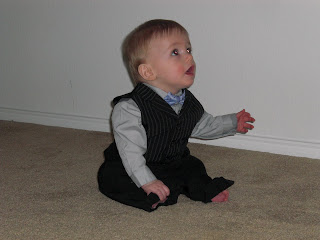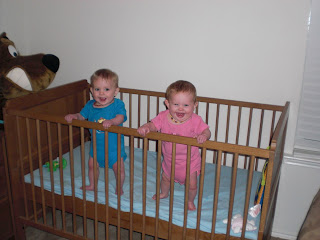Carpet and Ikea shelf
Next I found someone selling their toy box and knew I wanted it. We still have the sign that says it was made by "grandpa Trent" proudly displayed. It's a conversation starter if nothing else!
ABC toy box in corner
I spent a lot of time looking for the perfect bookcase. I knew what I wanted and was having trouble finding it. I did find one being sold by a family that was moving and picked it up. This was all that we had in the room for a long time. It gave the babies lots of room to roll, crawl, and safely explore.
Perfect bookcase :)
Then it was time for the big sale. There is a kids furniture and toy company near us that has a huge warehouse sale once a year. Everything is 50-80% off retail. This is high quality wood furniture and they had many things I wanted. This is not a sale for wimps. No kids allowed, stand in line for hours, and parents literally fighting to get what they want. There were a couple of things I would have liked, but was not willing to get in a physical fight so we went without. Still, we did great. We got 8 things for less than the cost of one of the larger items retail. Otherwise, we wouldn't have any of the wonderful things you see in our photos.
Truck table in top right corner
Dress up station, toy box, and kitchen
Close up of dress up station
Ikea shelf, book shelf, and giant doll hosue
We changed the arrangement of the room multiple times. I drove my husband crazy with all of my requirements for arranging the room. Here's a short list of some requirements - The dress up clothes needed to go next to the kitchen so it would be the "dramatic play" area. The furniture that would have toys dumped from them and played with on the floor couldn't go near each other. This would include the ikea shelf, bookshelf, and kitchen in our room. By keeping these separate, it slightly reduces the mess and all of the toys don't end up in a giant pile. Everything needed to be secured so the kids couldn't pull it over on themselves. No furniture they could climb on could be near the baby gate so they wouldn't climb over. Our playroom doesn't have a door, so this was extremely important. Here's the layout we ended up with:
This gave the kids things to pull up on around the outside and plenty of room to learn to walk in the middle. The table did not have chairs at it, they were put away for when they were old enough to use them safely. This was a great set up until just after the kids were a year and a half. That change will have to wait for another post though!




















